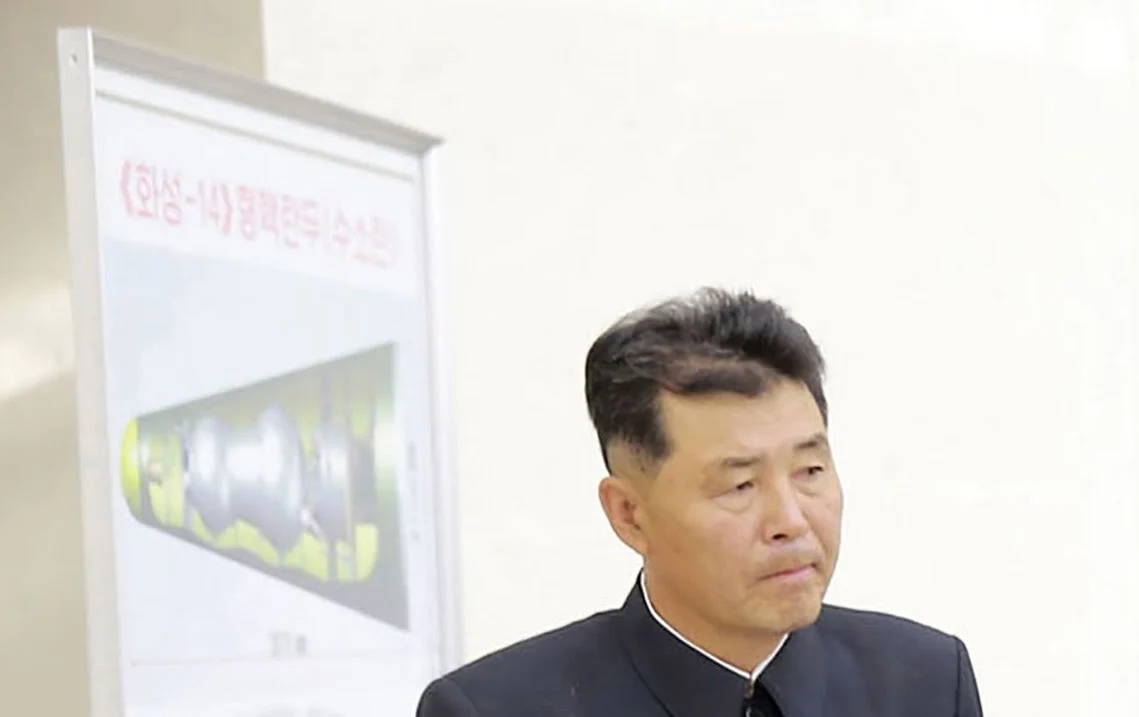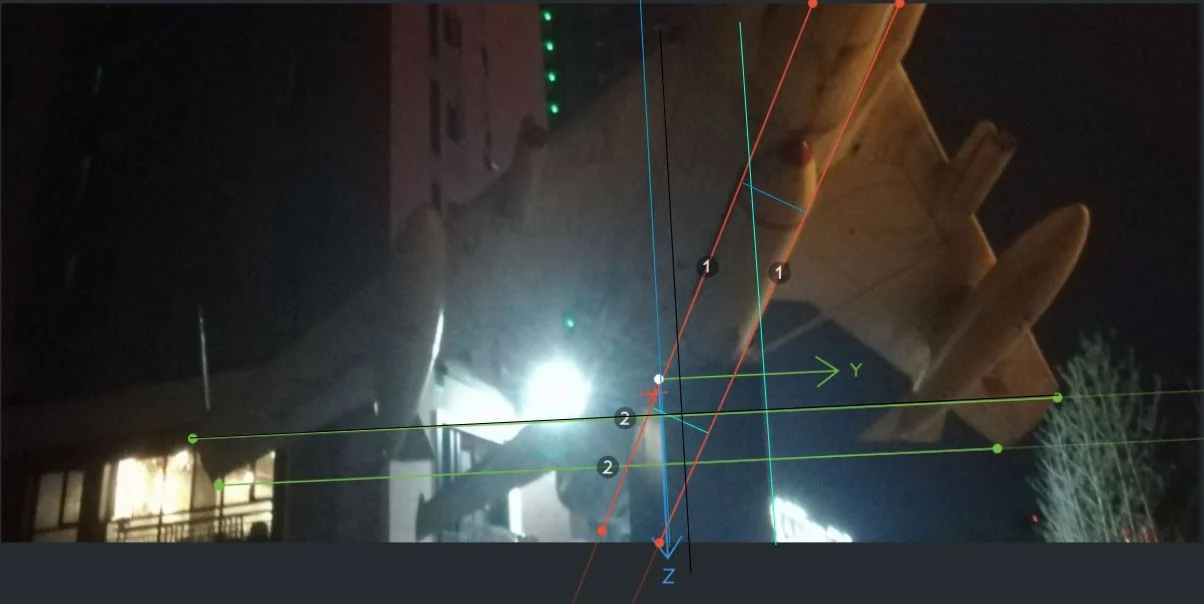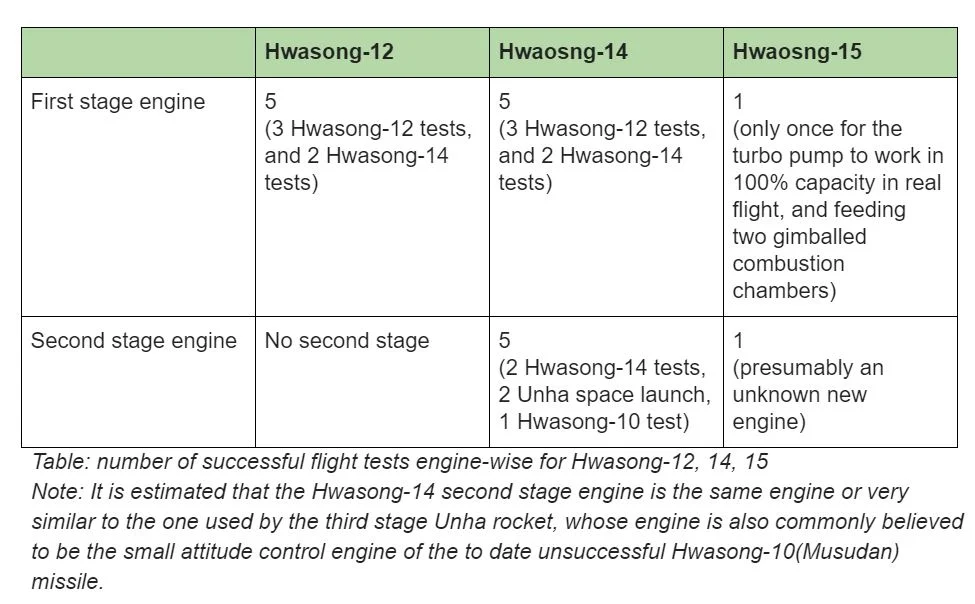
* The article was originally published on ONN's Datayo platform.
A few hours before the sixth nuclear test of the Democratic People's Republic of Korea (DPRK) on 3 September 2017, its state media showed the world an image of a purported thermonuclear bomb small enough to be mounted on the lightweight Hwasong-14 intercontinental ballistic missile (ICBM.) However, Pyongyang may be exaggerating its technical advancement. This means capping DPRK’s nuclear and ICBM tests is of paramount importance to the US, which already sees a missile capable of delivering a fission device to the US mainland intolerable.

Figure 1. Pyongyang exhibited a Hwasong-14 reentry vehicle (RV) design containing a two-stage thermonuclear bomb [1] on 3 September 2017. Credit: KCNA
Technology Level of DPRK’s Bombs
Prior to the 2006 nuclear test, DPRK informed Beijing that it will test a device with 4 kt desired yield. [2] Based on this yield, it was speculated that in order to achieve weaponisation quickly, a device small enough to be mounted onto a missile was detonated, though the estimated yield of less than 1 kt led Chinese experts to deem the test as only a partial success. [3] However, Pyongyang has continued its efforts and a "miniaturised and lighter nuclear device with greater explosive force" was detonated in the third test. [4] In the hindsight of the sixth nuclear test and the ICBM tests, the "miniaturisation in the first try" theory is more widely accepted.
Images of early DPRK atomic bombs are scarce and unconfirmed for accuracy. In 2017, a state TV report celebrating the completion of the nuclear arsenal displayed a photo of the late leader Kim Jong Il, who seemed to be inspecting an atomic bomb. [5] The device's size is similar to the model Kim Jong Un inspected in March 2016, which is estimated to be approxomiatly 60 cm in diameter and 200 to 300 kg [6] in weight.
On 3 September 2017, DPRK state media broadcast images of Kim Jong Un purportedly inspecting a two-stage thermonuclear device hours before DPRK's biggest nuclear test. Afterwards, another image of the bomb was shown in celebration of the test at a concert.
However, there are few items in these images that can be used as accurate references for measurement. Using an average adult head width to give a rough estimate of the calibre of DPRK rockets, the author got a rough result of ~42 to ~46 cm for the primary in the September 2017 photo and ~65 cm for the March 2016 device. This very crude method leaves a big margin of error. However, it suggests that DPRK bombs in display are generally consistent in size (~60 cm diameter, estimated weight 200 to 300 kg), if not getting smaller.
 Figure 2. From left to right: Kim Jong Il possibly inspecting an implosion device or model (pic 1), Kim Jong Un with a purported implosion device in 2016 (pic 2). Using average adult head width as reference to give a very rough estimate on the size of the DPRK thermonuclear device (pic 3, 4). Credit: KCNA, KCTV
Figure 2. From left to right: Kim Jong Il possibly inspecting an implosion device or model (pic 1), Kim Jong Un with a purported implosion device in 2016 (pic 2). Using average adult head width as reference to give a very rough estimate on the size of the DPRK thermonuclear device (pic 3, 4). Credit: KCNA, KCTV
So how advanced is DPRK's physical package? A good reference is the Chinese Kuangbiao-1 atomic bomb used in China's 13th nuclear test [7] (1972), which aimed to develop a small atomic bomb as the "trigger" of a compact hydrogen bomb. According to measurement the ~8 kt device's diameter may have been reduced to below ~60 cm. [8] The Kuangbiao-1 is likely not gas-boosted as China did not begin experimenting with gas-boosting until 1976, if not later. [9] In other words, the size of DPRK's atomic bomb is roughly on par with the Chinese bomb in the early 1970s.
It is estimated the DPRK lightweight ICBM Hwasong-14 can reach the US west coast with a reentry vehicle (RV, the spacecraft coming back to earth that contains the bomb) that weighs around 500 kg. [10] Thus, if the RV only contains a 200 to 300 kg atomic bomb (RV 300 to 400 kg in total), it would be able to cover more targets in the US. However, a RV about 500 kg in total would seem to be a very tight fix for a DPRK hydrogen bomb.

Figure 3. Measurement of the Kuangbiao-1 bomb’s diameter using Q-5's wing width (9.68 m) as reference. Blue and green lines point to two vanishing points beyond the photo. X,Y and Z represent rectangular coordinates in space. Photo credit: cjdby

Figure 4. Hurricane-1 experimental nuclear aerial bomb model exhibited in Beijing, China (left). It is a common misunderstanding that Kuangbiao-1 is a hydrogen bomb. It is actually an atomic bomb as shown by the nameplate on the model (right). Credits: Tencent news (left), Huanqiu (right).
Hwasong-15 Is the Hydrogen Bomb Carrier
DPRK detonated its most powerful bomb in early September and flight tested the Hwasong-15 on 28 November 2017. The missile's first stage is based on the same technology of Hwasong-14's, but it is a larger missile with ~60% more lift-off thrust. Roughly speaking, its RV weight is nearly double that of Hwasong-14. This weight is in general accordance with the presumed weight of DPRK RVs. [11]

DPRK said the Hwasong-15 is armed with a "super-large heavy warhead," [12] which could be the high yield device [13] tested in September 2017. The device, in turn, is closely associated with the Hwasong-15. After its flight test in November 2017, a DPRK official reiterated that DPRK was interested in talks with the US only after "detonation of a large-scale hydrogen bomb and testing of a long range missile". [14] After the flight test, DPRK announced its nuclear arsenal as complete.
Thus, the Hwasong-14 RV diagram containing a whole hydrogen bomb shown on 3 September 2017 may well be a deception to conceal the then-secret Hwasong-15 project. In case of Hwasong-15 failure, Pyongyang can confuse the world about its capabilities.
Conclusions
The author is not arguing that the Hwasong-14, probably an ICBM armed with a "mere" fission device, is not scary, but that it is meaningful to keep the testing moratorium. For example, without further miniaturisation a solid fuel ICBM carrying a Hwasong-15 RV could be more challenging to DPRK.
Nevertheless, each nuclear weapon developer has a comfort zone where the device's yield, reliability and one’s own industry base are in harmony with one another. Thus DPRK's declaration of having completed its nuclear arsenal may not be purely politically driven. However, even repeating previous tests would increase DPRK's confidence.
Pyongyang has been threatening to make a new strategic weapon. While there are plenty of scary options, increasing the yield of its fusion device (megaton yield, for example) could be it. Since the DPRK probably does not have a tunnel strong enough to hold such a high yield device, Kim Jong Un may choose between building such a device without testing or performing a powerful high altitude or atmospheric test far away from DPRK territory.

[1] We can tell that the smaller sphere is the fusion/secondary stage and the bigger sphere is the fission/primary stage for the following reasons: normally the secondary is put upfront to ensure aerodynamic stability because of its higher density. The bigger sphere (often called atomic bomb/primary stage/trigger bomb/implosion device) is connected with other devices such as the battery and detonator, as is shown in the diagram. Such a two-stage thermonuclear device is commonly called the "hydrogen bomb".
[2] Zhang Hui, Revisiting DPRK's Nuclear Test, Belfer Center, Summer 2007, available at: https://www.belfercenter.org/publication/revisiting-north-koreas-nuclear-test
[3] Zhang Hui, Revisiting DPRK's Nuclear Test, Belfer Center, Summer 2007, available at: https://www.belfercenter.org/publication/revisiting-north-koreas-nuclear-test
[4] North Korea confirms "successful" nuclear test: KCNA, Reuters, 12 Feburary 2013, available at: https://www.reuters.com/article/us-korea-north-kcna/north-korea-confirms-successful-nuclear-test-kcna-idUSBRE91B07I20130212
[5] Alistair Coleman, North Korean TV appears to show early "A-bomb photo", BBC, 13 December 2017, availabel at: https://www.bbc.com/news/world-asia-42339666
[6] Max Fisher, Jugal Patel, What One Photo Tells Us About North Korea's Nuclear Program, New York Times, 24 Feburary 2017, availabel at: https://www.nytimes.com/interactive/2017/02/24/world/asia/north-korea-propaganda-photo.html
[7] China Military Encyclopedia, Book of Nuclear Weapon, Military Science Press, 1990
[8] See figure 3, 4
[9] 中国氢弹之父”于敏去世 [Father of Chinese hydrogen bomb died], China News, 16 January 2019, available at: http://www.chinanews.com/gn/2019/01-16/8730808.shtml; Xu Zhilei resume, China Knowledge Center for Engineering Sciences and Technology, available at: http://ysg.ckcest.cn/ysgDetails/timeLine/73/rsdd.html
[10] A compilation of different estimates of Hwasong-14's payload and range. See: Michael Elleman, North Korea's Hwasong-14 ICBM: New Data Indicates Shorter Range Than Many Thought, available at: https://www.38north.org/2018/11/melleman112918/
[11] Nodong, Federation Of American Scientists, available at: https://fas.org/nuke/guide/dprk/missile/nd-1.htm; Lee Keun Pyung, North's SLBM has range of 2,800 km: report, Korea Joong Ang Daily, 11 November 2019 available at: https://koreajoongangdaily.joins.com/news/article/article.aspx?aid=3070120; Markus Schiller, Robert H. Schumucker, The Unha-3: Assessing the Successful North Korean Satellite Launch, Public Interest Report, Winter 2013, Volume 66 Number 1; North Korea rocket "has 10,000km range", BBC, 23 December 2012, available at: https://www.bbc.com/news/world-asia-20830605; David Wright, Analysis of North Korea's Musudan Missile Test, All Things Nuclear, 24 June 2016, 5 July 2016, available at: https://allthingsnuclear.org/dwright/analysis-of-north-koreas-musudan-missile-test-part-1, https://allthingsnuclear.org/dwright/12349; Hwasong-12, Missile Threat, 24 June 2019, available at: https://missilethreat.csis.org/missile/hwasong-12/; John Schilling, North Korea's Large Rocket Engine Test: A Significant Step Forward for Pyongyang's ICBM Program, 38 North, 11 April 2016, available at: https://www.38north.org/2016/04/schilling041116/
[12] DPRK Gov't Statement on Successful Test-fire of New-Type ICBM, KCNA, 29 November 2017
[13] Geoff Brumfiel, Here's How Big North Korea's Latest Nuclear Test Actually Was, NPR, 7 September 2017, available at: https://www.npr.org/sections/thetwo-way/2017/09/07/549155856/here-s-how-big-north-korea-s-latest-nuclear-test-actually-was?t=1590401940500
[14] North Korea missile launch: The most important things to know, CNN, 29 November 2017, availabe at: https://m.cnn.com/en/article/h_8678d86b0ad9e2f0229d4f39136a2b32